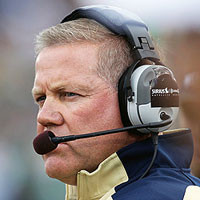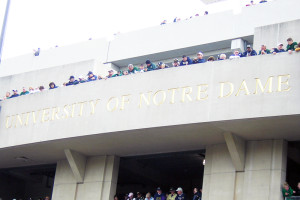
As Brian Kelly works week-by-week to gain a reprieve — or at least put some more space between himself and last year’s 4-8 collapse — Notre Dame was outgained by Michigan State 496 yards to 355, yet still came out of East Lansing with a 38-18 win. The Irish capitalized on three first-half Spartan turnovers and sealed the win with tough-enough defense and a moderately solid, yet determined, offensive effort.
Heading into the game, Notre Dame, and particularly quarterback Brandon Wimbush, had faced questionas about their effectiveness through the air, with wild pendulum swings in the ground game, and found themselves facing what promised to be a staunch, old-school Michigan State B1G/Big Ten defense.
Notre Dame responded by coming out throwing in their opening drive. Wimbush’s passing was nowhere near spectacular, neither especially precise nor well-timed; yet he nevertheless was uncharacteristically efficient and productive, with 62 yards on 4 of 5 passing in the opening drive, punctuated by a 40-yard heave to Equanimeous St. Brown.
(Admittedly, St. Brown had to dive for the ball, with no run after the catch, despite the fact that the receiver was open and should have received a more well-timed pass. Wide receivers Chase Claypool and St. Brown, along with other receivers throughout the night, demonstrated athleticism and grace snagging sometimes-poorly placed Wimbush throws.)
Claypool also had key catches on the opening drive, and the 40-yard catch by St. Brown set up the Irish on the Spartan 16. Wimbush himself used his legs to get the opening touchdown on the ground, getting stuffed on the next play but then running it in from 16 yards out on the play after that.
Wimbush would finish with only 176 passing yards and 1 passing touchdown, although he was reasonably efficient with 14 of 20 passing (70%). He also did rush for 52 yards and the opening touchdown. Even more importantly, given the way things played out, Wimbush was part of a team effort that featured zero Notre Dame turnovers. So no interceptions by Wimbush, and no fumbles by anybody in a white jersey. In contrast, Michigan State sophomore quarterback Brian Lewerke had both an interception and a fumble, while Wimbush had neither.
Despite being a junior in his second year of game action, Wimbush still fills the persona of a rookie starter. And some of the standards for a rookie starter are to not throw the game away, to run the operation and to have whatever contributions he can make injected judiciously into the overall team effort. By not committing turnovers in a game pivoting on turnovers, against an elite program that has been plagued by turnovers, and by making key plays here and there, however much they relied, at times, on the superior ability of team mates, Wimbush “did his job” in important ways.
With Notre Dame up 7-0, Michigan State’s own opening possession helped set the tone for the night. The Spartans were able to move the ball, albeit with some painstaking effort against the moderately improved Notre Dame defense, only to see the tide turned dramatically when Lewerke throw an interception for a pick-6. At a tune when the Spartans surging towards mid-field, Lewerke’s errant pass was snagged by Notre Dame defensive back Julian Love at the Notre Dame 45 and run back by Love for a 55-yard Notre Dame return touchdown. Notre Dame was up 14-0 less than five minutes into the game.
Michigan State, nevertheless, looked like they might shrug off the pick-six and reassert their elite form that has characterized most of Mark Dantonio’s tenure prior to last year’s downturn. Down 14-0, the Spartans drove 75 yards in 7 plays, including a 52-yard run by the quarterback that brought them to the Notre Dame 14. The Spartan quarterback tossed a 4-yard touchdown pass to make the score 14-7 with 6:33 to go in the 1st. Ironically, it was the same Notre Dame defensive back who earlier had scored off the pick-six who gave up the touchdown. The cornerback was nearly blanketing the Michigan State receiver in the end zone, with his back to the ball, and might actually have snagged another interception had he known to turn and make a play on what was a slightly underthrown ball. As it was, the receiver was able to make a leap and grab the ball nearly over the defender, resulting in a minor melee with both players trying to end up with it but Michigan State securing the touchdown.
After both teams stiffened on defense and struggled to move the ball on offensive, trading several punts, several minutes into the 2nd quarter Notre Dame linebacker Greer Martini forced a Michigan State fumble on the Spartan 24, separating the ball from quarterback Lewerke.
Working with a short field, Notre Dame struck decisively, but not as quickly as it seemed. It took the Irish 2:23 to move the ball 24 yards on 6 plays, a mix of short passes and short-to-medium runs, capped off by an 8-yard pass from Wimbush to running back Dexter Williams. On the play, Williams ran a route out of the backfield and was not really properly picked up by the Michigan State defenders. Wimbush did do a decent job of eventually spotting Williams and dropping a pass down near the back corner of the end zone, although Williams had to leap for the pass and had to engage in some minor acrobatics to get one foot down just barely inside the sideline.
In any even, Notre Dame was now up 21-7, on the strength of one good, long drive on the opening possession, a pick-six and a short field after a fumble recovery.
Michigan State, who already had developed a problem with turnovers heading into their Notre Dame game, once again shrugged off the turnover and looked like they were returning to competitive form, marching 74 yards in 9 plays.
However, on a Michigan State running play launched from the Notre Dame 15, where the Irish defense actually started out looking porous and a bit hapless, and as Spartan running back L.J. Scott seemed poised to practically fly across the goal line, Notre Dame defensive back Shaun Crawford redeemed the Irish defense by stripping the ball almost right at the goal line. Crawford himself recovered the Spartan fumble in the end zone, for what amounted to a 3- or 7-point swing. Instead of Michigan State pulling back within one score with the touchdown, or at least getting a chip-shot field goal after being so deep in Irish territory, Notre Dame was still up 21-7, and were getting the ball back on the 20 after the touchback.
While Notre Dame did not have a short field this time, they did get the 7-point swing from the turnover, and, perhaps more importantly, responded like a good competitor by seizing on the change in momentum to strike while the iron was hot. The Irish immediately mounted a strong offensive effort that went 80 yards in 5 plays to push the lead to 28-7.
With Notre Dame’s ground game, in a season marked by wild pendulum swings, there has been some question about just how good or bad the rushing attack really is, and how consistently strong or athletic the offensive line and running backs really are. The Irish put up eye-popping numbers, even quasi-record-setting numbers against Temple and Boston College, yet were limited to 55 yards on the ground in a 1-point loss to a Georgia team barely in the top-15 (although the Bulldogs now are potentially destined to crack the top-10). Even among the eye-popping statistical avalanches of the first and third games, Notre Dame was sometimes styied or simply moderately decent on the ground, in between ripping off huge plays.
One interesting question is, what actually has happened on the rash of big plays. In some instances, they simply made good plays, while in some cases there seemed to be, all at once, a perfect storm of unusually good blocks, hard-running and, perhaps, the opponent being out of position. Against moderately solid opponents, there might be some specific plays where, instead just playing reasonably well, or getting temporarily stymied, the offensive line might resemble a cattle herd stampeding a village. And if, on that play, the opposing defense was out of position, and the running back chose that moment to run stongly enough to break a tackle, the running back might then have something resembling open tundra waiting for him beyond the broken tackle. We know that the running backs and quarterback do not necessarily have blazing speed, because, if they had blazing speed, the running backs would not get run down from behind by Boston College. Yet there is enough speed that, when combined with an overall perfect storm of a play, they can seize the moment can do some damage.
Against Michigan State, Notre Dame’s decisive momentum-accelerating drive to go up 28-7 in the second quarter was launched with a 30-yard scamper by running back Josh Adams that had 15 more yards packed on by a Spartan penalty.
A few plays later, Wimbush launched another one of his in-the-area heaves that demonstrated him to not be the best passer, but to still have enough arm strength to give someone else, perhaps with more athleticism, the chance to make the highlight reel, with an otherwise unnecessarily spectacular leap and dive after another semi-errant Wimbush heave. In this case, it was tight end Durham Smythe. Smythe hauled in a 21-yard Wimbush pass, diving headlong for it (even though he was open, and the pass should have been delivered to him more accurately with a better chance for an after-the-catch run). Alas, the touchdown would then be scored on the ground by running back Dexter Williams, who motored in from 14 yards out.
After Notre Dame’s 28-7 halftime margin, they were actually outscored 11-10 in the second half, although Michigan State’s final 8 points came in “junk time” with just about 3 minutes to go.
On the day, Notre Dame only rushed for 182 yards on 40 carries, while passing for 173 yards in 20 attempts. The Irish did average 4.6 yards per carry on the ground, although taking out a 30-yard run by Adams and a 32-yard run by Wimbush, the remaining carries produced 120 yards on 38 carries, at just a little more than 3 yards per carry for that subset of rushes. So the sprinkling of big plays still skews the running game assessment significantly. Nevertheless, of course, those yards do count, and contributed mightily to the outcome. Adams had 56 yards rushing on 9 carries, with the 30 on his longest carry. Wimbush had 52 yards on 8 carries, with the 32 on 1 carry. Williams had 40 yards rushing on 5 carries.
In borderline “junk time,” fresh face Deon McIntosh managed to pick up 35 yards on 12 carries, meaning he had the most carries on the night; and if he did just average 2.9 yards per carry, he still got valuable playing time.
The need for younger players to get game experience is an issue that has plagued a Brian Kelly tenure featuring a number of close games. Ironically, Kelly has been good at using a large number of players in regular rotations. However, in terms of getting future stars game experience by clearing the bench, a notable number of close games has, at times, arguably frustrated player development for the future. For example, one of the contributing factors for last year’s downturn was an almost unbelievable lack of experience in the wide receiver corps. Early on, then a thuggish goon hit by Texas knocked what was then Notre Dame’s only experienced wide receiver out of the game, it helped tip the balance. One of the factors that came out, at the time, was that Notre Dame’s receivers back then were not necessarily all freshman. Some of them had been in the program for a little while, yet had simply never made it onto the field, but might have if not for the problem of close games and failure to clear the bench. So it will be interesting to see if that is another problem that Kelly addresses this year, and if wider margins of victory can help alleviate the situation. And we now see that, with game action under their belts, the same wide receivers who were a liability early on last year with their inexperience are now a strength of the program, and a strength that is needed, given the weakness at the quarterback position.
Whether comparative weakness at the quarterback position continues, or whether either Wimbush or back-up Ian Book can develop into more of a championship quarterback, one interesting added twist will be whether Notre Dame can revive a past practice of getting the ball into the hands of wide-outs on running plays. One started to see a little bit of that against Michigan State, but not something that gained much traction thus far.
(Another interesting question, of course, is whether Wimbush himself could be converted to running back. He has shown the ability to build himself up physically, and might turn out to have at least some of the upper body strength associated with running back, and some of the moves and instincts for timing and cuts, even if his speed is moderate, not electric. On the other hand, if he remains in the quarterback position and is overused as a runner, one has to wonder about the cumulative impact of running-related hits on his accuracy as a passer. Of course, if Notre Dame really wanted to be both traditional and innovative, they might start wondering about Wimbush morphing into a kind of Gipper Back. George Gipp, possibly the greatest all-around player to ever play the game (also factoring his contributions as a defensive back and punter), who not only was a strong runner with a single-season school record for yards-per-carry, and a career rushing total that remained the school record well into the modern era, also contributed a sizable amount of passing yardage. Even in Gipp’s final game, the monstrous rushing talent also unleashed multiple long bombs as a passer. If Wimbush was, indeed, converted to running back that would not necessarily mean that he would never throw passes again.)
On defense, in addition to his pivotal interception and 55-yard return touchdown, cornerback Julian Love had 6 tackles. Cornerback Shawn Crawford forced the pivotal goal-line fumble by Michigan State that Crawford himself also recovered in the end zone, and additionally registered 4 tackles. Linebacker Nyles Morgan led the Irish with 9 tackles, with linebackers Greer Martini and Te’von Coney adding 7 tackles each, with Coney also getting a share of a tackle-for-loss. Notre Dame linebacker Drue Tranquill had a solo sack that he included among 6 total tackles. Linemen Jerry Tillery and Julian Okwara combined for another sack, one of 3 total tackles for Tillery.
The Irish rise to 3-1 on the year, as they head into a showdown with resurgent Miami of Ohio. The Redhawks are 8-3 across their last 11 games and are coached by former Notre Dame Offensive Coordinator Chuck Martin. In addition to having familiarity with Notre Dame as a former assistant coach, and presumably not being intimidated by the idea of playing at Notre Dame Stadium, Martin specifically has longstanding familiarity with Brian Kelly and Kelly’s system. Martin also won just as many small college national championships as Kelly before jumping to the big leagues, doing it at Kelly’s old stomping grounds at Grand Valley State. Time will tell, whether Chuck Martin can bring the same “jinx” against Brian Kelly that, by comparison, Notre Dame basketball coach Mike Brey represents against his former colleague Mike Krzyzewski (Brey was a key assistant at Duke for Krzyzewski, during Duke’s greatest heyday; and, as a Notre Dame coach, Brey eventually started showing signs of turning himself into a bit of a nemesis for Duke and Krzyzewski).
Brian Kelly already lost at home to another former Notre Dame assistant coach, when Skip Holtz led South Florida to a win over Notre Dame several years back. And Skip Holtz was simply familiar with the campus and therefore was not intimidated by the would-be mystique; he was not as closely familiar with Brian Kelly himself and not as familiar with Kelly’s program as Chuck Martin is.
In 2016, Miami of Ohio got into a bowl after a six-game winning streak in the second half of the season, followed by a bowl loss to Mississippi State of the SEC. Thus far in 2017, Miami of Ohio lost by 5 points at Marshall, beat Austin Peay by three touchdowns, lost by 4 points to Cincinnati, just now throttled Central Michigan by 17 points (incidentally, another one of Brian Kelly’s old stomping grounds, providing any interesting poetic symmetry to the Brian Kelly-Chuck Martin doomsday scenario for the Irish).
Look for the Redhawks to bring their best game to Notre Dame Stadium, look for them to get a multiplier effect from the Chuck Martin-Brian Kelly scenario and look for Notre Dame and Brian Kelly to risk a let-down because of Miami of Ohio’s lack of marquee value. On the other hand, one of the great ironies is that, as Notre Dame takes on the team from The Cradle of Coaches, they will be wearing a former Miami of Ohio coach’s name on their helmet: “Ara.” One way or another, it should be a colorful contest. And, between Ara, the Cradle of Coaches history, and the Brian Kelly-Chuck Martin connection, it should be even more traditional-laden than might have been expected. Of course, with two multiple national championship winners from the same former program squaring off, one would expect no less.
Heading into the season, looking at the landscape of the schedule, one might have wondered if Miami of Ohio would turn into Brian Kelly’s Waterloo, with Chuck Martin being the Duke of Wellington to Brian Kelly’s Napoleon. And it was when Les Martin stood at 4-4 that LSU let him go last year, even though Les Martin once one a major college national championship for LSU itself.
Considering that Temple and Boston College each had a much better year last year than Notre Dame, and considering that, even amidst Michigan State’s own downturn last year, the Spartans still beat Notre Dame, one might fairly have wondered out loud if Brian Kelly would be 2-2 or 1-3 at this point, heading into a tough game against a resurgent program led by a potential nemesis who knows all his secrets.
And a cynic might have noted that the gutting of the assistant coaching staff, and proliferation of assistant coaches who were solid and capable yet not luminaries with head coaching experience, meant, even if by accident, that it would be harder for Notre Dame to fire Brian Kelly at mid-season and appoint an interim coach from the assistants. It would mean that it would be harder for Notre Dame to do to Brian Kelly what Southern Cal did to Lane Kiffin, when Pat Haden fired him on an airport tarmac in the middle of the night next to a team bus after a bitter loss, when Southern Cal had the luxury of having an Ed Orgeron already on the coaching roster. Having Ed Orgeron around meant Southern Cal had a former SEC head coach serving as a coordinator, whom they could then quickly elevate to interim head coach. (Orgeron, of course, would later server as an interim coach at LSU, who treated Orgeron with a lot more savvy and fairness than Southern Cal did, later switching his interim role to permanent). Notre Dame has great assistant coaches, but they might not have an Ed Orgeron on staff.
Yet, one way or another, a retooled Brian Kelly is 3-1 with a retooled Notre Dame program. Even if he gets upset by Chuck Martin and Miami of Ohio, he still would have his head above water at 3-2. The more likely scenario, of course, is that Miami of Ohio will bring a dogfight but Notre Dame will be able to out-muscle the Redhawks enough times for another stat-distorting ground game. But if the Irish don’t take care of the football, and lapse into mistakes and turnovers, a sleepy start against against a potential nemesis could spell derailment for the BK Express.






